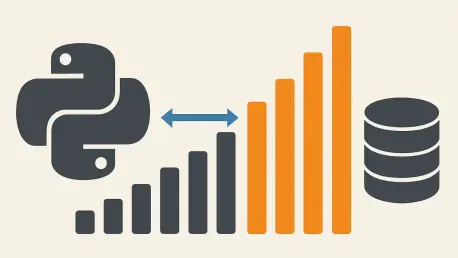In today’s rapidly evolving landscape of web development, Python developers are increasingly drawn to asynchronous programming as a powerful means to elevate application performance, particularly for AI-driven projects that demand real-time responsiveness. The transition from traditional synchronous frameworks like Django to async-first alternatives such as FastAPI marks a significant shift, unlocking new possibilities for managing concurrent tasks with reduced latency. This exploration delves into the transformative impact of asynchronous Python on database interactions, focusing on two widely used systems: SQLite and PostgreSQL. By examining a developer’s journey through the complexities of this shift, the challenges and breakthroughs of integrating async Python with these databases come to light. From lightweight prototyping to robust production environments, the promise of efficiency shines through, though it often comes with hurdles that test technical expertise. This narrative aims to uncover how async Python reshapes database management, offering insights into its potential and pitfalls.
Unlocking Performance with Asynchronous Programming
Asynchronous programming in Python, leveraging the async/await syntax, empowers applications to handle multiple tasks concurrently, proving especially valuable for scenarios involving AI models that require simultaneous request processing. FastAPI, a cutting-edge web framework, champions this async-first philosophy, standing in sharp contrast to Django’s historically synchronous foundation. For developers crafting web-based AI tools, this translates into noticeably quicker response times when interfacing with external services or endpoints. The core appeal lies in the ability to support a larger volume of users or processes without overloading the server, fundamentally enhancing scalability. Beyond mere speed, adopting async Python necessitates a reimagining of application architecture, pushing developers to rethink traditional workflows and embrace a paradigm where waiting for I/O operations no longer stalls the entire system. This shift sets the stage for deeper innovations in how databases are accessed and managed within modern web ecosystems.
The drive toward asynchronous programming is fueled by the growing demand for applications that can manage high levels of concurrency without sacrificing performance. In the context of FastAPI, this means leveraging Python’s event loop to execute tasks like database queries or API calls without blocking other operations. This approach proves transformative for AI applications, where latency can make or break user experience, especially during interactions with complex models or large datasets. However, embracing this technology is not without its learning curve, as developers must adapt to new patterns of coding and debugging that differ significantly from synchronous methods. The promise of handling more simultaneous connections with less resource strain makes the effort worthwhile, particularly when paired with databases that can keep pace with async demands. This performance boost is a key motivator for exploring how SQLite and PostgreSQL integrate with async Python, revealing both opportunities and obstacles in real-world scenarios.
Database Dynamics in an Async Environment
When embarking on async Python projects, SQLite often emerges as the preferred choice for initial prototyping due to its lightweight nature and ease of use. Paired with libraries like aiosqlite, it integrates effortlessly into FastAPI applications, enabling developers to test concepts without grappling with intricate configurations. Tools such as SQLAlchemy for object-relational mapping and Alembic for migrations further streamline the process, making SQLite an ideal starting point for small-scale endeavors. Deployment on platforms like Fly.io or Railway becomes straightforward, as SQLite bypasses the need for advanced security measures like SSL, simplifying early-stage testing. This accessibility allows developers to focus on mastering async database operations, building a foundation of understanding before confronting the more demanding aspects of scaling up. SQLite’s role as a low-barrier entry point underscores its value in the async Python toolkit for experimentation.
As projects mature and require greater robustness, PostgreSQL often takes center stage in production settings, introducing a steeper set of challenges within an async framework. Unlike SQLite, which operates locally with minimal setup, PostgreSQL involves networked connections that demand careful handling of asynchronous connectors such as asyncpg or psycopg3. These tools, while designed for async compatibility, frequently present obstacles like SSL configuration issues or performance bottlenecks that can disrupt workflows. The transition to PostgreSQL tests a developer’s ability to manage database interactions beyond the simplicity of prototyping, highlighting the need for deeper expertise in network security and optimization. This step up reveals the true complexity of async Python in real-world applications, where the stakes of maintaining uptime and data integrity are significantly higher, pushing for innovative solutions to balance power with practicality.
Overcoming Challenges in Async Database Operations
Selecting an appropriate database connector for PostgreSQL within an async environment often proves to be a daunting task for many developers. Starting with synchronous options like psycopg2 can lead to conflicts with FastAPI’s async structure, creating inefficiencies in code execution. Moving to asyncpg may resolve some issues during development, but production environments often expose limitations, such as incompatibilities with SSL requirements on specific hosting platforms. Many find a workable solution in psycopg3, which offers a balance between async support and security needs, though the path to this resolution is typically marked by trial and error. Each connector brings unique challenges, compelling developers to adapt dynamically and continuously expand their technical knowledge. This iterative process underscores the nuanced difficulties of aligning database tools with the async paradigm, where flexibility must be matched with precision.
Security emerges as a paramount concern when deploying PostgreSQL in production settings under async Python frameworks. While SQLite sidesteps complexities like SSL in simpler deployments, PostgreSQL’s reliance on secure connections becomes non-negotiable, especially on hosted services with strict protocols. Misconfigurations in SSL across various connectors can halt progress, particularly when platforms lack detailed guidance for async setups. Addressing these security barriers demands a thorough understanding of network configurations, often extending beyond traditional coding skills into the realm of infrastructure management. Successfully navigating these hurdles requires diligence and sometimes a shift in perspective, as developers must prioritize secure data transmission alongside application functionality. This aspect of async database management illustrates the broader responsibilities that come with scaling projects, where safeguarding user data is as critical as performance.
Performance challenges also surface prominently with PostgreSQL in async contexts, particularly concerning prepared statements intended to optimize query execution. These statements can inadvertently cause application crashes due to connection pooling conflicts on certain platforms, necessitating their deactivation. While this might initially seem like a compromise on efficiency, solutions like SQLAlchemy’s statement caching help mitigate the impact, preserving performance levels. Unlike SQLite, where such issues are negligible due to its in-memory operation, PostgreSQL’s networked nature demands meticulous tuning to avoid bottlenecks. This contrast highlights the inherent trade-offs between managing local versus remote databases in async environments, where each decision can significantly affect application stability. Developers must remain agile, adapting strategies to ensure that performance gains from async Python are not undermined by database-specific pitfalls.
Ecosystem Trade-offs: Django and FastAPI
The exploration of async Python often prompts a comparison between Django’s highly structured ecosystem and FastAPI’s more flexible, unopinionated approach to development. Django provides a comprehensive suite of built-in tools for tasks like authentication and database management, creating a supportive environment that reduces setup complexity for developers. This protective framework allows for quicker project initiation, as many decisions are pre-made within its opinionated design. In contrast, FastAPI requires manual integration of components, from user authentication systems to admin interfaces, placing greater responsibility on developers to construct their ideal stack. While this freedom enables highly customized solutions, it also introduces a steeper learning curve for those accustomed to Django’s streamlined processes. The differing philosophies shape how async database interactions are approached, balancing ease against adaptability in modern web development.
Performance remains a compelling reason to adopt FastAPI despite its challenges, as its async-first design excels in scenarios demanding high concurrency, such as AI applications with real-time data processing needs. The trade-off is evident: forgoing Django’s user-friendly structure for FastAPI’s superior speed and scalability. This pursuit of performance drives continuous experimentation with databases like SQLite and PostgreSQL in async settings, even when faced with significant obstacles. Developers often find themselves weighing the benefits of customization against the raw efficiency of asynchronous processing, a decision that can redefine project outcomes. FastAPI’s ability to handle numerous simultaneous connections with minimal resource strain positions it as a forward-thinking choice, particularly for cutting-edge applications. This focus on performance underscores the transformative potential of async Python, encouraging innovation even amidst ecosystem complexities.
Charting the Future of Async Database Integration
The journey with async Python and databases like SQLite and PostgreSQL extends far beyond current challenges, pointing toward exciting possibilities for future development. Developers are already exploring advanced integrations, such as vector databases tailored for AI-driven data handling, which could redefine how information is stored and accessed. Streamlining toolsets to focus on a curated selection of compatible components is a priority, aiming to reduce friction in async workflows. Community collaboration plays a vital role, as shared insights and feedback help refine practices and uncover new solutions. FastAPI’s rising popularity signals a shift in the development landscape, where lessons from database management struggles inform more cohesive architectures. This ongoing evolution reflects a collective commitment to harnessing async Python’s full potential, paving the way for more efficient and innovative web applications.
Reflecting on past efforts, the exploration of async Python with SQLite and PostgreSQL revealed a landscape of both opportunity and challenge that shaped development practices. Struggles with connectors, security configurations, and performance tuning tested resilience, yet each obstacle overcome contributed to a deeper understanding of asynchronous systems. Looking ahead, the focus turned to actionable steps like adopting standardized tools and fostering community-driven knowledge sharing to ease future transitions. The integration of emerging technologies, such as specialized databases for complex AI needs, stood out as a promising direction for enhancing capabilities. Developers found inspiration in collaborative learning, recognizing that shared experiences could accelerate progress in mastering async Python. These next steps, built on the foundation of past trials, aimed to simplify the path for others, ensuring that the benefits of reduced latency and heightened concurrency became more accessible across diverse projects.









